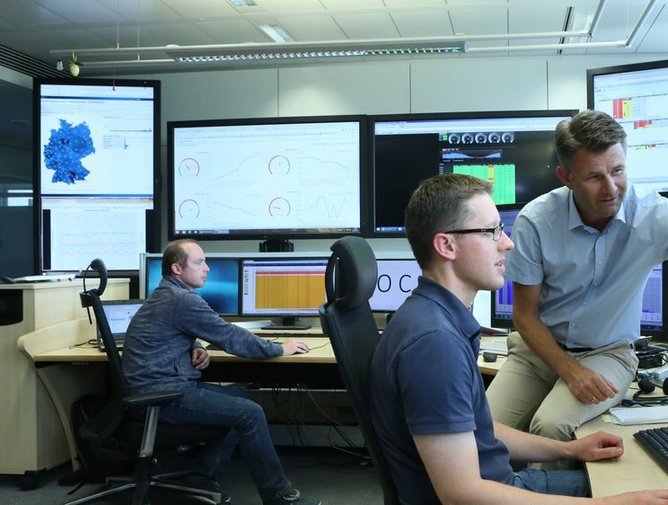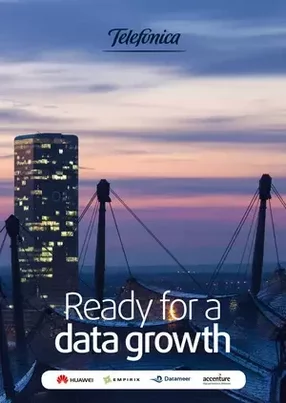Since it entered the German market in 2005 with the acquisition of the O2, Telefónica has become one of the three leading integrated telecommunications providers in Germany. In the mobile segment alone, Telefónica Deutschland is the market leader. In 2014 Telefónica Deutschland acquired E-Plus Mobilfunk GmbH. Now the company is working on a simplified management structure across Telefónica Deutschland’s entire mobile access, core and fixed network operations.
Quality monitoring and surveillance this extensive network has been the responsibility of Marcus Thurand, VP of Network Operations since 2013, but his job has evolved almost out of recognition. The networks not only have to be reliable; they have to be smart enough to cope with a new era of communications. As the CEO Markus Haas pointed out in March at CeBIT, Hannover: “Due to the continuous progress of network technology, I have unlimited possibilities of using digital means to make life easier. Regarding the internet of things, we will see an enormous growth in connecting devices via Narrowband IoT. For instance electricity and water meters. Also with applications for consumer the internet of things will open entirely new dimensions in core areas such as mobility and health. This can only be beneficial for all of us.”
In order to meet all the increasing requirements our network has to be very resilient. Thurand and his team look after the 24-hour surveillance of the entire network, as well as configuration and integration and all new hardware and software affecting it, and providing network support to large business customers.
His department's emphasis has radically shifted with the setting up of a new Service Operations Centre. The company brought in Accenture to help define the shape of the innovative network organisation and the process of transitioning from the former model to the new SOC organisation. Launched on April 16 2017, the Munich-based centre has its own premises and staff. Its very existence shows how significant both perspectives are. The customer engagement is as much important as the inward-looking network management, he says. “These days we're looking at the network not only from a technical point of view but stronger from the user experience by trying to understand what the customers are really doing with our services.”
The Service Operations Centre uses custom built software. The system technology is mainly made available by long-time Telefónica partner Huawei. “Using this software we are able to look into the customer experience from interactions on the network and assess whether it was good or not,” says Thurand.
We all know that checking out a YouTube clip, for example, can be a very different experience. Sometimes it's perfect, sometimes it stalls or distorts. We are unlikely to know why, but now Telefónica can tell us. “We aggregate anonymous user experiences to see whether certain services in a certain region are behaving well or poorly and deduce whether we can do something about that and help the customer have a better experience,” Thurand explains.
This is just a starting point. The next step is to use the information to interact with the customer. “Perhaps a customer had a bad experience from our data service for example, and wants to complain,” Thurand continues. “We can provide informations up-front to customer service, tell them the performance in an application was not as it should be and there really was something at fault in the network. In that case we can work out with customer service any incentives we can give the customer in compensation. Going further we can be even more proactive because we already know about the issue. If the customer complaints, we can tell them we're aware the service was not good on that occasion and suggest what we can do to make it better.”
The new organisation shifts Telefónica's focus away from the purely technical, bringing customers into the discussion from the standpoint of what they are really doing with the network and experiencing it. No out-of-the-box software could do what was needed, so over a 12 month period a new platform was developed with Huawei. It's so much more than a matter of simply trawling for information. A key part of the mix is advanced analytics that will extract more information from the big data. The Huawei software is built around a Hadoop cluster, a framework that supports the processing and storage of extremely large data sets in a distributed computing environment. Hadoop's ability to run applications on systems with thousands of commodity hardware nodes, and to handle thousands of terabytes of data, means it can not only manage the requirements of Telefónica's existing network but potentially the exponential increase that will result for the growth of IoT as foreseen by Mr Haas.
Currently Marcus Thurand and his team are engaged in analysing anonymous customers' activity such as browsing, file downloading and uploading and popular applications like WhatsApp and YouTube. “We started in April and we need to see what are the applications our customers are using, and trying to bring new applications – such as mytaxi which are very German market specific. The idea is to measure whether the app is working well for customer groups, provide feedback to these groups and offer help if we detect a problem.”
Once the system has been trialled for a reasonable period, he would like to collaborate with the companies that make the apps people access on the network. “In the future I'd like to have service level agreements (SLAs) with these companies and agree on certain key performance indicators (KPIs). After all we must surely collaborate to give the best service to our mutual customers. When we find a problem then we could call them, or they us, and say there is an issue.” Perhaps surprisingly, this sort of cooperation is rare between network service providers and large software developers such as Google. “But why not start now?” Thurand says.
Telefónica Deutschland is the first group company to roll out this software. By correlating customer behaviour, customer complaints and customer churn it can help identify regional anomalies like poor data throughput, cut the numbers switching away and encouraging more to switch to Telefónica. “But we don't just want them to stay,” says Thurand, “we want to get new customers on board and let them see the value we can give to them. It started with my organisation at network operations but we are going to involve customer service, marketing, communications, and other departments. We want to roll it out into different areas of the company so we can all use this information we are now getting about our customer's real-world experience.”
It's been a busy year for Marcus Thurand and his team, who have had to expand their centre of attention from the system to its users. “We are investing a lot in the change management and training so employees have a better understanding of their future role,” he continues. “It has also been a challenge to set up the software, which for every single interaction on the network has to analyse and put an evaluation marker on it – assessing it, noting any problems and their severity and where they originate.”
Customers will quickly see the benefits in the form of fast responses to problems, even ones they may not have been aware of. In a business with so many employees it can be harder to spot problems. The SLAs Telefónica has with customers may be comfortably achieved, yet small groups, senior executives or frequently travelling salespeople for example, may still have problems. “With the new tools, we can quickly break down the macro information and see where problems lurk. That gives us the opportunity to revisit the SLAs and provide these customers with a better level of service.”
Thurand remains confident that the system will yield benefits in customer satisfaction, retention and acquisition as well as fitting Telefónica's network for the exponential data growth that will come when everyone's refrigerator is jostling for bandwidth.




